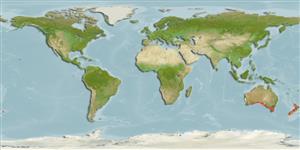>
Syngnathiformes (Pipefishes and seahorses) >
Syngnathidae (Pipefishes and seahorses) > Syngnathinae
Etymology: Hippocampus: Greek, ippos = horse + Greek,kampe = curvature (Ref. 45335).
Environment: milieu / climate zone / depth range / distribution range
البيئة
بحري; مياه مخلوطة القاع; غير مهاجرة; نطاق العمق 0 - 104 m (Ref. 52034). Temperate; 24°S - 50°S, 80°E - 120°W (Ref. 52034)
Southwest Pacific: Australia and New Zealand (Ref. 115213). Occurrence in Thailand and the Philippines (Ref. 43081) needs verification.
Length at first maturity / الحجم / وزن / العمر
Maturity: Lm 8.7 range ? - ? cm
Max length : 35.0 cm OT ذكر/ مختلط الجنس; (Ref. 6787); common length : 18.0 cm OT ذكر/ مختلط الجنس; (Ref. 9003)
الأشواك الظهرية (المجموع): 0; الأشعة الظهرية الناعمة (المجموع): 25-31; شوكة شرجية 0; أشعه شرجية لينه: 4.
Found in large rock pools at low tide. They remain motionless amidst seaweed. Juveniles are pelagic (Ref. 30915) or attached to drifting seaweeds (Ref. 31838). Feed on minute crustaceans (e.g. copepods and amphipods). Nocturnal (Ref. 9003). Ovoviviparous (Ref. 205). The male carries the eggs in a brood pouch which is found under the tail (Ref. 205). Seen in groups at night. Also around jetties and other man-made objects; attached to sponges and colonial hydroids in deeper water (Ref. 30915). Length measurements refer to height (= TL - head length).
This is the largest seahorse species in southeastern Australia, and has more dorsal fin rays and tail rings than any other seahorse (Ref. 31838). Sold locally and internationally for the aquarium trade (Ref. 31838). Dried and sold to the Oriental medicine trade as a tonic and aphrodisiac (Ref. 5316, 34026).
Several subsequent broods are carried by the male in a brood pouch during the spawning season. Do not obviously pair, as other seahorses do (Ref. 30915). Fertilised eggs deposited by females in the pouch of males are incubated for about four weeks before hatching (Ref. 31838). Hatching occurs at night, coinciding with full moon periods during summer months (Ref. 31838). Young emerge from the pouch and immediately rise to the surface where they grasp floating debris with their tail (Ref. 31838).
Lourie, S.A., R.A. Pollom and S.J. Foster, 2016. A global revision of the seahorses Hippocampus Rafinesque 1810 (Actinopterygii: Syngnathiformes): taxonomy and biogeography with recommendations for further research. Zootaxa 4146(1):1-66. (Ref. 115213)
IUCN Red List Status (Ref. 130435)
استخدامات بشرية
مصائد: غير ذات اهمية; حوض مائي: تجاري
مزيد من المعلومات
مراجعالأستزراع المائيملف الأستزراع المائيسلالاتجينيElectrophoresesالتوريثالأمراضمعالجةNutrientsMass conversion
أدوات
تقارير خاصة
Download XML
مصادر علي الأنترنت
Estimates based on models
Preferred temperature (Ref.
123201): 14.1 - 19.8, mean 17 °C (based on 322 cells).
Phylogenetic diversity index (Ref.
82804): PD
50 = 0.5000 [Uniqueness, from 0.5 = low to 2.0 = high].
Bayesian length-weight: a=0.00447 (0.00177 - 0.01127), b=3.00 (2.78 - 3.22), in cm total length, based on LWR estimates for this (Sub)family-body shape (Ref.
93245).
مستوى غذائي (Ref.
69278): 3.4 ±0.0 se; based on diet studies.
المرونه (Ref.
120179): عالي, الحد الزمني الأدني لتضاعف عدد أفراد المجتمع أقل من 15 شهر (tm=1; Assuming annual Fec<1000).
Fishing Vulnerability (Ref.
59153): Low vulnerability (10 of 100).
Nutrients (Ref.
124155): Calcium = 61.4 [38.8, 114.6] mg/100g; Iron = 0.447 [0.279, 0.744] mg/100g; Protein = 17.8 [16.8, 18.9] %; Omega3 = 0.543 [0.315, 0.933] g/100g; Selenium = 15.8 [7.9, 37.3] μg/100g; VitaminA = 9.31 [3.19, 26.90] μg/100g; Zinc = 0.702 [0.518, 0.958] mg/100g (wet weight);
